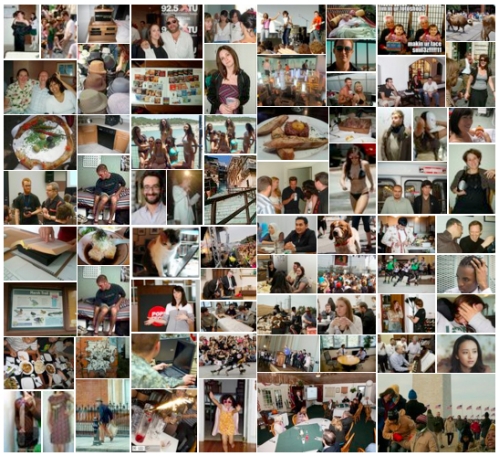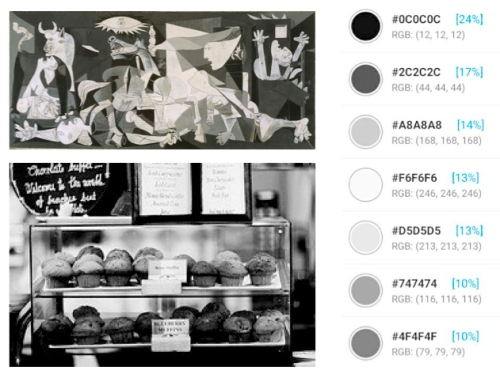unAware.
Performance collettiva inconsapevole, 2020.
Programmazione di tag NFC.
Sedendosi con il cellulare in tasca su uno di questi tag NFC, se il lettore NFC è attivo e si ha un profilo Twitter, in automatico si posta il messaggio.
unAware.
Unconscious Collective Performance, 2020.
NFC tag coding.
Sitting with your mobile phone in your pocket on one of these NFC tags, if the NFC reader is active and you have a Twitter profile, you will automatically post the message.
——-
Analogia.
Performance digitale, 2020.
Scomposizione delle immagini in valori esadecimali RGB.
Ricerca di immagini con valori esadecimali equivalenti.
Analogy.
Digital performance, 2020.
Decomposition of images into RGB hexadecimal values.
Search for images with equivalent hexadecimal values.
White #FFFFFF RGB (255, 255, 255)
Grey #808080 RGB (128, 128, 128)
Black #000000 RGB (0, 0, 0)
Red #FF0000 RGB (255, 0, 0)
Brown #800000 RGB (128, 0, 0)
Yellow #FFFF00 RGB (255, 255, 0)
Green #008000 RGB (0, 128, 0)
Blue #0000FF RGB (0, 0, 255)
Leonardo, Gioconda, 1503.
Henri Matisse, La danza, 1909.
Pablo Picasso, Guernica, 1937.
Wim Wenders, Il cielo sopra Berlino, 1987.
——-
Andrea Roccioletti: What does your artistic work consist of?
Jack Pavlik: Earlier in my career I was committed to moving semi-rigid materials; kinetic constructions that were motor powered and some using digital technology. This work was satisfying in a modern art context, but something was missing. I needed to bring the human form into my work. I wanted to bring the base urges of people into sculpture and performative situations. In the body of work that uses the folding chairs I was able to make mini comedies and dramas of competitive actions between human shapes. In the end I realized that I was making work that was related to my kinetic work. Instead of moving and manipulating metal, I was moving people.
Zero Sum Sitting 1 from jack pavlik on Vimeo.
AR: Why the choice of chairs?
JP: Chairs represent a number of things. They are figurative in themselves and they also call out for a human shape when they are unoccupied. Depending on the type of chair they can signify class, institutions, conformity, etc. In my work the opening and closing of the folding chair, and forcing one person out of a chair have to do with competition and rejection in human and societal relationships.
AR: What do you think of the current local and international artistic situation?
JP: In the U.S. we have the same funding issues we have always had, but now this is coupled with the pandemic. I do not know what the future holds but it will be a struggle to get back to what we had. We could lose many museums and institutions if governments and those with the money do not see the value in culture production.
Difficult Sitting from jack pavlik on Vimeo.
AR: What do you think the artist’s job is, if he has one?
JP: The best artists will stay true to their own vision and interpretations. I believe in political art but it is mostly post-mortem analysis of the political scene. I would like to think there is art that can help people see the truth about political and societal manipulation, but I have yet to see it.
AR: What advice would you give to the public regarding the vision of contemporary art?
JP: Believe in it. Not all art you see is great, but there is great art to see that is being made by contemporary artists.
Zero Sum Sitting – Academic Version 3 from jack pavlik on Vimeo.
——-
Consigli di lettura:
M.Atwood, Esercizi di potere, Nottetempo.
F.Merlini, L’estetica triste, Bollati.
T.Ariemma, L’Occidente messo a nudo, Sossella.
R.Simone, Il software del linguaggio, Cortina.
M.Bettini, Il mito, Mulino.
S.Tramma, Sulla maleducazione, Cortina.
F.Caldarola, Filosofia dell’arte contemporanea, Quodlibet.
N.Herschdorfer, Il corpo, Einaudi.
——-

——-















molto interessante !
"Mi piace""Mi piace"
Ciao Nadia, grazie!
"Mi piace""Mi piace"
Mitico! (buon anno 🙂
"Mi piace""Mi piace"
Scritto però con la voce di Galeazzi 🙂 🙂 🙂 https://www.youtube.com/watch?v=J4ZU7ihvmjU
"Mi piace""Mi piace"